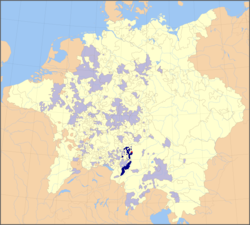
Back Hochstift Augsburg German Augsburgi piiskopkond Estonian Principauté épiscopale d'Augsbourg French בישופות אאוגסבורג HE Kepangeranan-Keuskupan Augsburg ID Principato vescovile di Augusta Italian Prinsbisdom Augsburg Dutch Аугсбургское княжество-епископство Russian Prince-Bishopric of Augsburg SIMPLE ราชรัฐมุขนายกเอาคส์บวร์ค Thai
This article needs additional citations for verification. (March 2011) |
Prince-Bishopric of Augsburg Fürstbistum Augsburg | |||||||||
|---|---|---|---|---|---|---|---|---|---|
| c. 888–1803 | |||||||||
 Augsburg territory (blue) in 1648 | |||||||||
| Status | Prince-Bishopric (State of the Holy Roman Empire) | ||||||||
| Capital |
| ||||||||
| Government | Elective principality | ||||||||
| Historical era | Middle Ages | ||||||||
• Bishopric established | 4th century | ||||||||
• Gained territory and thus, Imperial immediacy | c. 888 | ||||||||
• City of Augsburg gained Imperial immediacy as a Free Imperial City | 1276 | ||||||||
| 1530 | |||||||||
• City joined Schmalkaldic League | 1537 | ||||||||
| 1555 | |||||||||
| 1632–35 | |||||||||
• Mediatised to Bavaria | 25 February 1803 | ||||||||
| |||||||||
The Prince-Bishopric of Augsburg (German: Fürstbistum Augsburg; Hochstift Augsburg) was one of the prince-bishoprics of the Holy Roman Empire, and belonged to the Swabian Circle. It should not be confused with the larger diocese of Augsburg, over which the prince-bishop exercised only spiritual authority.
The city of Augsburg proper, after it gained free imperial status, was a separate entity and constitutionally and politically independent of the prince-bishopric of the same name. The prince-bishopric covered some 2365 km2 and had approximately 100,000 inhabitants at the time it was annexed to Bavaria in the course of the German mediatization.[1]
- ^ Gerhard Köbler, Historisches Lexikon der Deutschen Länder: die deutschen Territorien vom Mittelalter bis zur Gegenwart, 2007 revised edition, p. 31.
